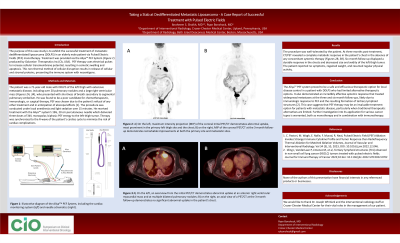Ablative Therapy
(24) A Case Report of Successful Treatment of Metastatic Liposarcoma with Pulsed Electric Fields
Saturday, September 23, 2023
6:00 PM - 7:30 PM East Coast USA Time

Ryan Bonshock, MD – Interventional Radiologist, IR, Crozer-Chester Medical Center
Purpose: The purpose of this case study is to exhibit the successful treatment of metastatic liposarcoma in an elderly male patient via Pulsed Electric Fields (PEF) monotherapy.
Material and Methods: The patient was a 71-year-old male with dedifferentiated liposarcoma (DDLPS) of the left thigh with extensive metastatic disease, including over 20 pulmonary nodules and a large right ventricular mass, who presented with shortness of breath secondary to segmental pulmonary embolism. He was found to be a poor candidate for chemotherapeutic, immunologic, or surgical therapy. He received treatment with the Aliya™ PEF System (Galvanize Therapeutics Inc, CA, USA). PEF was chosen due to the patient’s refusal of any other treatment and in anticipation of abscopal effects. The procedure was conducted under local anesthesia and light sedation over 15 minutes, using the system’s 19G, 20 cm percutaneous needle to deliver three doses of 3kV, monopolar, biphasic PEF energy to the left thigh tumor. Therapy was synchronized to the R-wave of the patient's cardiac cycle to minimize the risk of cardiac complications.
Results: The procedure was well-tolerated by the patient. At three months post-treatment, CT/PET revealed a complete metabolic response in the patient's chest. Six-month follow-up displayed stable chest findings and decreased size of the left thigh tumor. The patient reported no symptoms, regained weight, and resumed regular physical activity.
Conclusions: The Aliya™ PEF system proved to be a safe and efficacious therapeutic option for local disease control in a patient with DDLPS who had limited alternative therapeutic options. It also demonstrated an incredibly effective systemic response that treated widespread metastases at the three and six-month follow-ups, likely due to immunologic response to PEF and the resulting formation of tertiary lymphoid structures. This case suggests that PEF therapy may be an invaluable treatment option for patients with metastatic disease, particularly when traditional therapeutic alternatives are limited. Further investigation into its application for various cancer types is warranted, both as monotherapy and in combination with immunotherapy.
Material and Methods: The patient was a 71-year-old male with dedifferentiated liposarcoma (DDLPS) of the left thigh with extensive metastatic disease, including over 20 pulmonary nodules and a large right ventricular mass, who presented with shortness of breath secondary to segmental pulmonary embolism. He was found to be a poor candidate for chemotherapeutic, immunologic, or surgical therapy. He received treatment with the Aliya™ PEF System (Galvanize Therapeutics Inc, CA, USA). PEF was chosen due to the patient’s refusal of any other treatment and in anticipation of abscopal effects. The procedure was conducted under local anesthesia and light sedation over 15 minutes, using the system’s 19G, 20 cm percutaneous needle to deliver three doses of 3kV, monopolar, biphasic PEF energy to the left thigh tumor. Therapy was synchronized to the R-wave of the patient's cardiac cycle to minimize the risk of cardiac complications.
Results: The procedure was well-tolerated by the patient. At three months post-treatment, CT/PET revealed a complete metabolic response in the patient's chest. Six-month follow-up displayed stable chest findings and decreased size of the left thigh tumor. The patient reported no symptoms, regained weight, and resumed regular physical activity.
Conclusions: The Aliya™ PEF system proved to be a safe and efficacious therapeutic option for local disease control in a patient with DDLPS who had limited alternative therapeutic options. It also demonstrated an incredibly effective systemic response that treated widespread metastases at the three and six-month follow-ups, likely due to immunologic response to PEF and the resulting formation of tertiary lymphoid structures. This case suggests that PEF therapy may be an invaluable treatment option for patients with metastatic disease, particularly when traditional therapeutic alternatives are limited. Further investigation into its application for various cancer types is warranted, both as monotherapy and in combination with immunotherapy.
